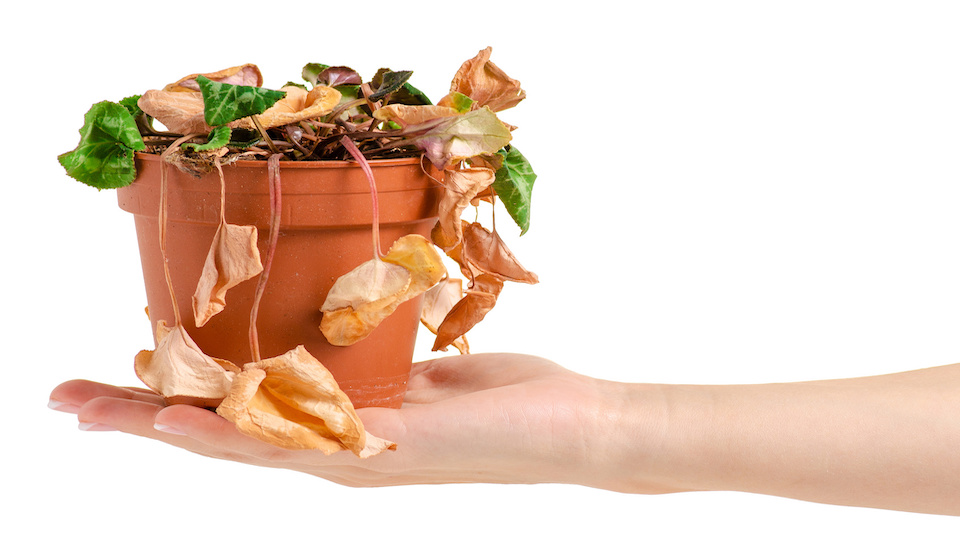Houseplants bring great joy and health benefits to any home. Unfortunately, even under the most diligent care, they don’t always thrive. If your houseplants are looking a little ragged, don’t despair! You can still nurse it back to health. These are the most common reasons your houseplant may be struggling and steps to revive it.
Reasons your plant is unhappy
The problem: Overwatering
Many people see a wilted plant and immediately assume that it just needs more water. In reality, water could be the very reason your plant is struggling to stay alive. Stick your finger in the soil close to your plant; if it is wet further than an inch down and it’s been a few days since you watered, you may be guilty of overwatering. The leaves of your plant may also turn brown or yellow and will usually seem soggy when touched.
The solution: Make sure that your plant has appropriate drainage and is not sitting in water. For instance, if there is a drainage hole in the bottom of the pot, but you have a tray underneath to catch the water, empty this tray. Keep it out of direct sunlight and only water lightly until your plant heals and the leaves return to a healthy color.
The problem: Underwatering
Though far less common than overwatering, the neglectful plant parent may still occasionally forget to water their plants for long periods. Leaves will often seem dry and may crumble off the plant at the slightest touch. The soil is usually receding from the edges of the pot, and it is often incredibly hard.
The solution: Place the plant in a humid area, such as the bathroom for a few days and water regularly. It will have trouble absorbing the moisture at first so you may need to give it another drink every few hours until the soil starts to retain water.
The problem: Too much sun
The leaves will usually be bleached and dried out. Your plant may also be wilting and have sunburn spots.
The solution: Simply move your plant to a more shaded area. Don’t place it in a completely dark location as this could shock it. You will want to put it somewhere that it can get gentle, filtered light.
The problem: Not enough sun
Plants that aren’t getting enough sun will usually become leggy and start to stretch toward a light source.
The solution: Move it to a sunny window or if you live in a house with limited natural light, consider investing in an artificial grow light. You can also try adding light-colored gravel to the pot to help reflect the sun onto the leaves.
Steps for reviving your sad plant
Sometimes it can be hard to identify what exactly is wrong with your plant, and it just looks a little “meh.” Or maybe you decided to shop the discounted houseplants that need a little TLC when you bring them home. Either way, these steps will help give your plant new life.
- Repot
Plants aren’t always in the pot that is right for them. If your plant has outgrown its pot or if there is inadequate drainage or soil, repot it in a bigger container. You may need to add more soil and fertilizer as well.
- Trim off dead leaves
Use a simple pair of scissors or small garden shears to trim off any dead or dying leaves. It is vital to make room for new growth and see what you are working with.
- Change location
Many plants are simply in the wrong place in your home. Give your sad houseplant some new real estate, and it will often return to full health. For instance, if your plant is languishing in a sunny windowsill, it may want more filtered light, if you have a waterlogged plant in the bathroom, move it to a less humid room.
- Add nutrients
Fertilizer can do wonders for houseplants; however, it is often overlooked. If the soil doesn’t have enough organic material or if your houseplant is a heavy feeder, you will need to add supplemental nutrients to give it a boost. Use old coffee grounds, tea bags, add a scoop of compost, or use a traditional houseplant fertilizer.
- Be patient
The healing process isn’t going to happen overnight. Once you’ve done all you can for your sad houseplant, you will have to wait and be patient. Give it a few weeks of dedicated care, and if you don’t notice any change or it seems to get worse, there may be another problem such as disease or dead roots.
-Taylor Ramsey




